Edible Arrangements: Consumer Behavior and Marketing Strategies Report
VerifiedAdded on 2023/01/18
|14
|3105
|74
Report
AI Summary
This report provides a comprehensive analysis of Edible Arrangements' marketing strategies, focusing on the new 'buy online pick up in store' service. It begins by describing the service's characteristics, including intangibility, inseparability, and non-standardization. The report then explores the five dimensions of service quality (reliability, assurance, tangibles, empathy, and responsiveness) and details methods for measuring service quality using RATER metrics. The impact of technology on service delivery is also discussed. Furthermore, the report identifies potential barriers to globalizing the service, such as physical distance and cultural differences, and provides a detailed marketing mix strategy (distribution, price, and promotion) to overcome these challenges and effectively market the service. The analysis concludes with a summary of the key findings and recommendations for Edible Arrangements to optimize its marketing efforts and enhance customer satisfaction.
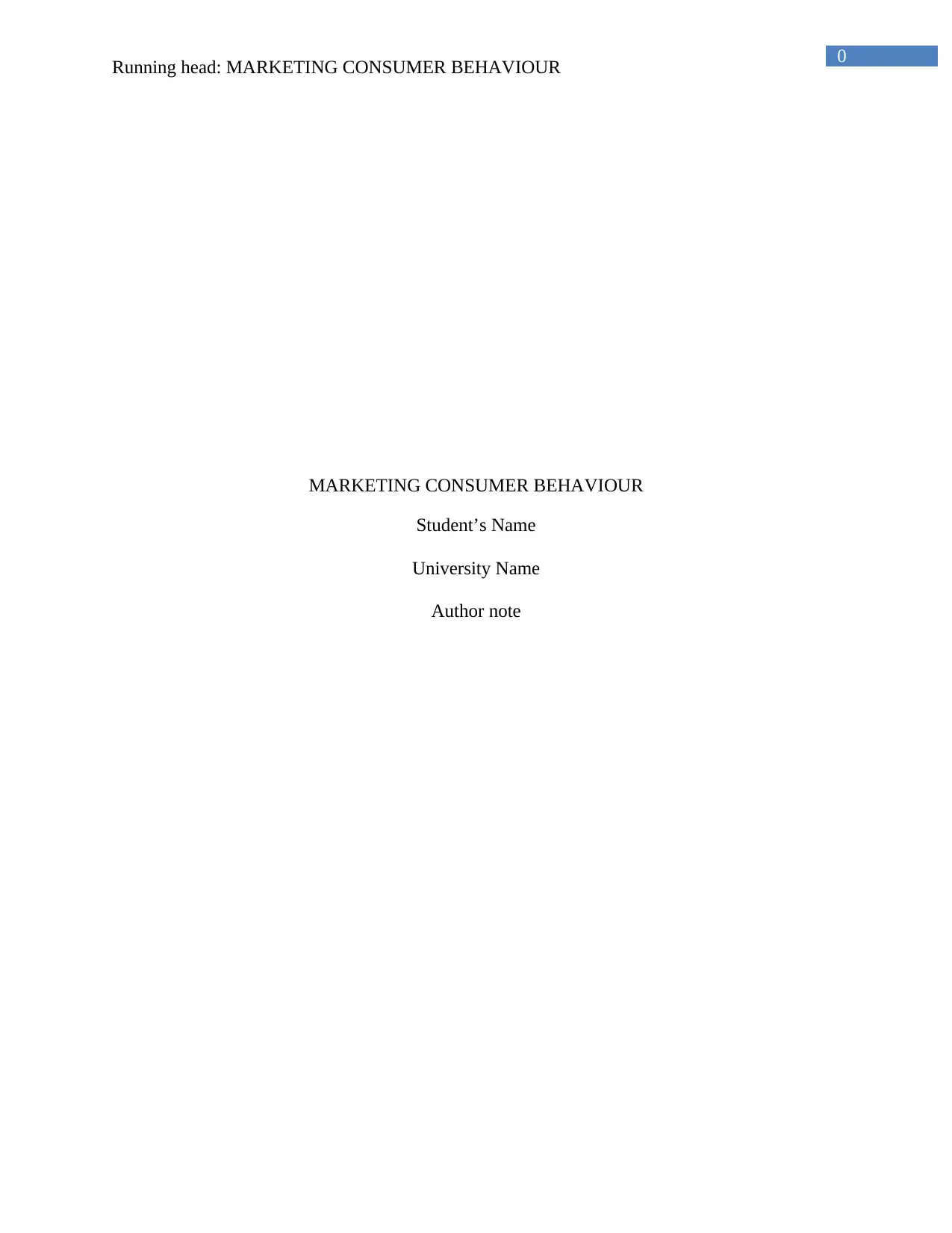
Running head: MARKETING CONSUMER BEHAVIOUR
MARKETING CONSUMER BEHAVIOUR
Student’s Name
University Name
Author note
0
MARKETING CONSUMER BEHAVIOUR
Student’s Name
University Name
Author note
0
Paraphrase This Document
Need a fresh take? Get an instant paraphrase of this document with our AI Paraphraser
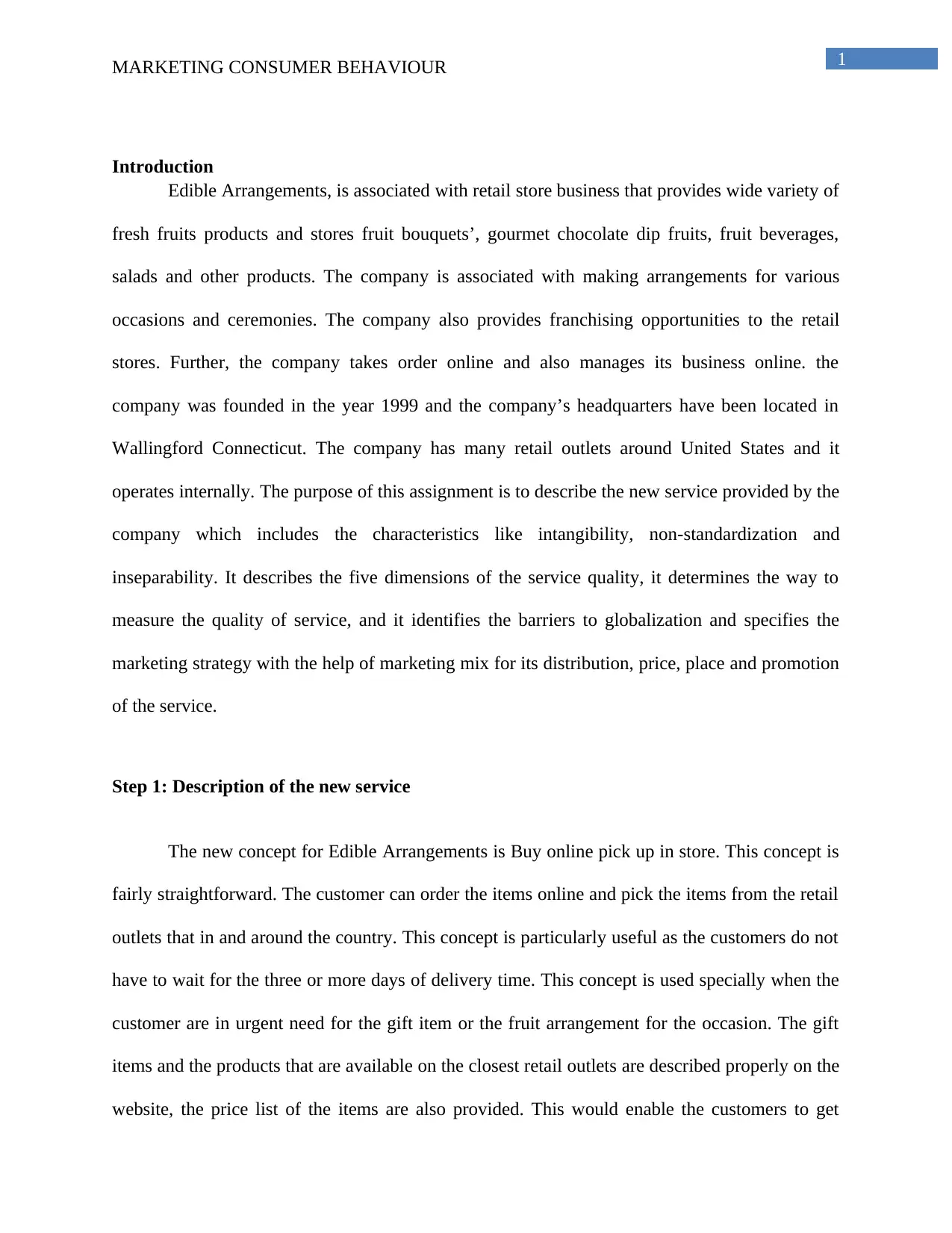
1MARKETING CONSUMER BEHAVIOUR
Introduction
Edible Arrangements, is associated with retail store business that provides wide variety of
fresh fruits products and stores fruit bouquets’, gourmet chocolate dip fruits, fruit beverages,
salads and other products. The company is associated with making arrangements for various
occasions and ceremonies. The company also provides franchising opportunities to the retail
stores. Further, the company takes order online and also manages its business online. the
company was founded in the year 1999 and the company’s headquarters have been located in
Wallingford Connecticut. The company has many retail outlets around United States and it
operates internally. The purpose of this assignment is to describe the new service provided by the
company which includes the characteristics like intangibility, non-standardization and
inseparability. It describes the five dimensions of the service quality, it determines the way to
measure the quality of service, and it identifies the barriers to globalization and specifies the
marketing strategy with the help of marketing mix for its distribution, price, place and promotion
of the service.
Step 1: Description of the new service
The new concept for Edible Arrangements is Buy online pick up in store. This concept is
fairly straightforward. The customer can order the items online and pick the items from the retail
outlets that in and around the country. This concept is particularly useful as the customers do not
have to wait for the three or more days of delivery time. This concept is used specially when the
customer are in urgent need for the gift item or the fruit arrangement for the occasion. The gift
items and the products that are available on the closest retail outlets are described properly on the
website, the price list of the items are also provided. This would enable the customers to get
Introduction
Edible Arrangements, is associated with retail store business that provides wide variety of
fresh fruits products and stores fruit bouquets’, gourmet chocolate dip fruits, fruit beverages,
salads and other products. The company is associated with making arrangements for various
occasions and ceremonies. The company also provides franchising opportunities to the retail
stores. Further, the company takes order online and also manages its business online. the
company was founded in the year 1999 and the company’s headquarters have been located in
Wallingford Connecticut. The company has many retail outlets around United States and it
operates internally. The purpose of this assignment is to describe the new service provided by the
company which includes the characteristics like intangibility, non-standardization and
inseparability. It describes the five dimensions of the service quality, it determines the way to
measure the quality of service, and it identifies the barriers to globalization and specifies the
marketing strategy with the help of marketing mix for its distribution, price, place and promotion
of the service.
Step 1: Description of the new service
The new concept for Edible Arrangements is Buy online pick up in store. This concept is
fairly straightforward. The customer can order the items online and pick the items from the retail
outlets that in and around the country. This concept is particularly useful as the customers do not
have to wait for the three or more days of delivery time. This concept is used specially when the
customer are in urgent need for the gift item or the fruit arrangement for the occasion. The gift
items and the products that are available on the closest retail outlets are described properly on the
website, the price list of the items are also provided. This would enable the customers to get
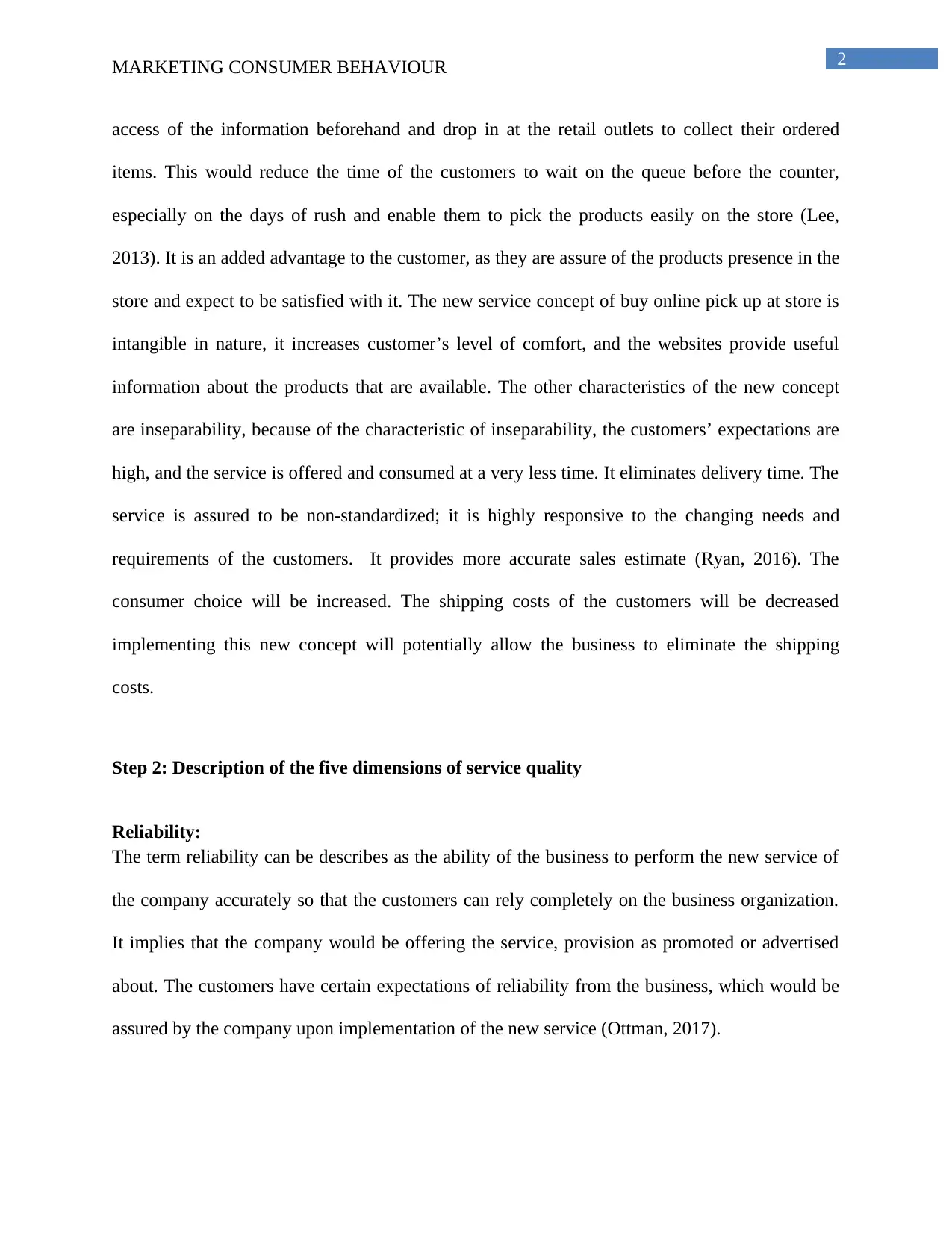
2MARKETING CONSUMER BEHAVIOUR
access of the information beforehand and drop in at the retail outlets to collect their ordered
items. This would reduce the time of the customers to wait on the queue before the counter,
especially on the days of rush and enable them to pick the products easily on the store (Lee,
2013). It is an added advantage to the customer, as they are assure of the products presence in the
store and expect to be satisfied with it. The new service concept of buy online pick up at store is
intangible in nature, it increases customer’s level of comfort, and the websites provide useful
information about the products that are available. The other characteristics of the new concept
are inseparability, because of the characteristic of inseparability, the customers’ expectations are
high, and the service is offered and consumed at a very less time. It eliminates delivery time. The
service is assured to be non-standardized; it is highly responsive to the changing needs and
requirements of the customers. It provides more accurate sales estimate (Ryan, 2016). The
consumer choice will be increased. The shipping costs of the customers will be decreased
implementing this new concept will potentially allow the business to eliminate the shipping
costs.
Step 2: Description of the five dimensions of service quality
Reliability:
The term reliability can be describes as the ability of the business to perform the new service of
the company accurately so that the customers can rely completely on the business organization.
It implies that the company would be offering the service, provision as promoted or advertised
about. The customers have certain expectations of reliability from the business, which would be
assured by the company upon implementation of the new service (Ottman, 2017).
access of the information beforehand and drop in at the retail outlets to collect their ordered
items. This would reduce the time of the customers to wait on the queue before the counter,
especially on the days of rush and enable them to pick the products easily on the store (Lee,
2013). It is an added advantage to the customer, as they are assure of the products presence in the
store and expect to be satisfied with it. The new service concept of buy online pick up at store is
intangible in nature, it increases customer’s level of comfort, and the websites provide useful
information about the products that are available. The other characteristics of the new concept
are inseparability, because of the characteristic of inseparability, the customers’ expectations are
high, and the service is offered and consumed at a very less time. It eliminates delivery time. The
service is assured to be non-standardized; it is highly responsive to the changing needs and
requirements of the customers. It provides more accurate sales estimate (Ryan, 2016). The
consumer choice will be increased. The shipping costs of the customers will be decreased
implementing this new concept will potentially allow the business to eliminate the shipping
costs.
Step 2: Description of the five dimensions of service quality
Reliability:
The term reliability can be describes as the ability of the business to perform the new service of
the company accurately so that the customers can rely completely on the business organization.
It implies that the company would be offering the service, provision as promoted or advertised
about. The customers have certain expectations of reliability from the business, which would be
assured by the company upon implementation of the new service (Ottman, 2017).
⊘ This is a preview!⊘
Do you want full access?
Subscribe today to unlock all pages.

Trusted by 1+ million students worldwide
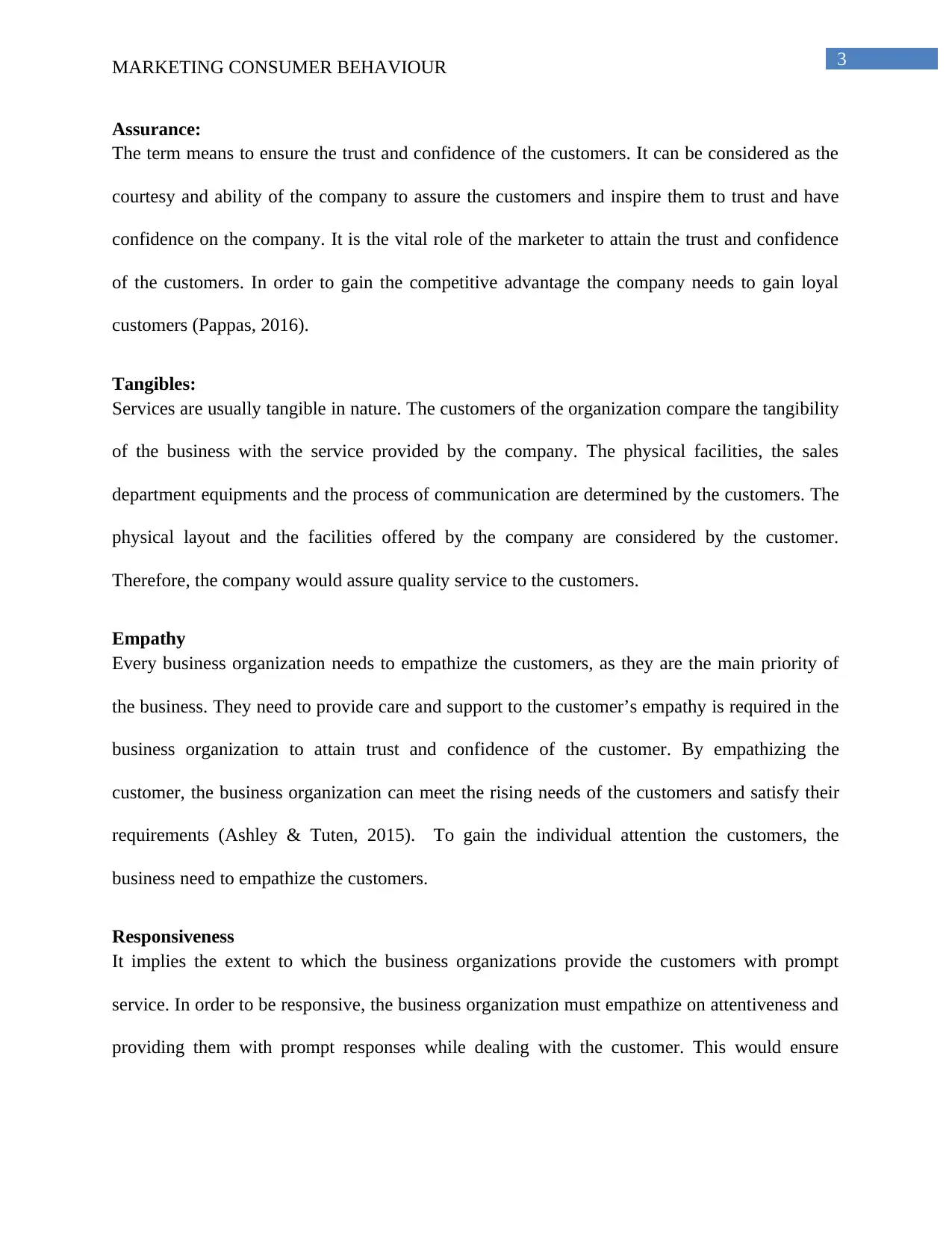
3MARKETING CONSUMER BEHAVIOUR
Assurance:
The term means to ensure the trust and confidence of the customers. It can be considered as the
courtesy and ability of the company to assure the customers and inspire them to trust and have
confidence on the company. It is the vital role of the marketer to attain the trust and confidence
of the customers. In order to gain the competitive advantage the company needs to gain loyal
customers (Pappas, 2016).
Tangibles:
Services are usually tangible in nature. The customers of the organization compare the tangibility
of the business with the service provided by the company. The physical facilities, the sales
department equipments and the process of communication are determined by the customers. The
physical layout and the facilities offered by the company are considered by the customer.
Therefore, the company would assure quality service to the customers.
Empathy
Every business organization needs to empathize the customers, as they are the main priority of
the business. They need to provide care and support to the customer’s empathy is required in the
business organization to attain trust and confidence of the customer. By empathizing the
customer, the business organization can meet the rising needs of the customers and satisfy their
requirements (Ashley & Tuten, 2015). To gain the individual attention the customers, the
business need to empathize the customers.
Responsiveness
It implies the extent to which the business organizations provide the customers with prompt
service. In order to be responsive, the business organization must empathize on attentiveness and
providing them with prompt responses while dealing with the customer. This would ensure
Assurance:
The term means to ensure the trust and confidence of the customers. It can be considered as the
courtesy and ability of the company to assure the customers and inspire them to trust and have
confidence on the company. It is the vital role of the marketer to attain the trust and confidence
of the customers. In order to gain the competitive advantage the company needs to gain loyal
customers (Pappas, 2016).
Tangibles:
Services are usually tangible in nature. The customers of the organization compare the tangibility
of the business with the service provided by the company. The physical facilities, the sales
department equipments and the process of communication are determined by the customers. The
physical layout and the facilities offered by the company are considered by the customer.
Therefore, the company would assure quality service to the customers.
Empathy
Every business organization needs to empathize the customers, as they are the main priority of
the business. They need to provide care and support to the customer’s empathy is required in the
business organization to attain trust and confidence of the customer. By empathizing the
customer, the business organization can meet the rising needs of the customers and satisfy their
requirements (Ashley & Tuten, 2015). To gain the individual attention the customers, the
business need to empathize the customers.
Responsiveness
It implies the extent to which the business organizations provide the customers with prompt
service. In order to be responsive, the business organization must empathize on attentiveness and
providing them with prompt responses while dealing with the customer. This would ensure
Paraphrase This Document
Need a fresh take? Get an instant paraphrase of this document with our AI Paraphraser
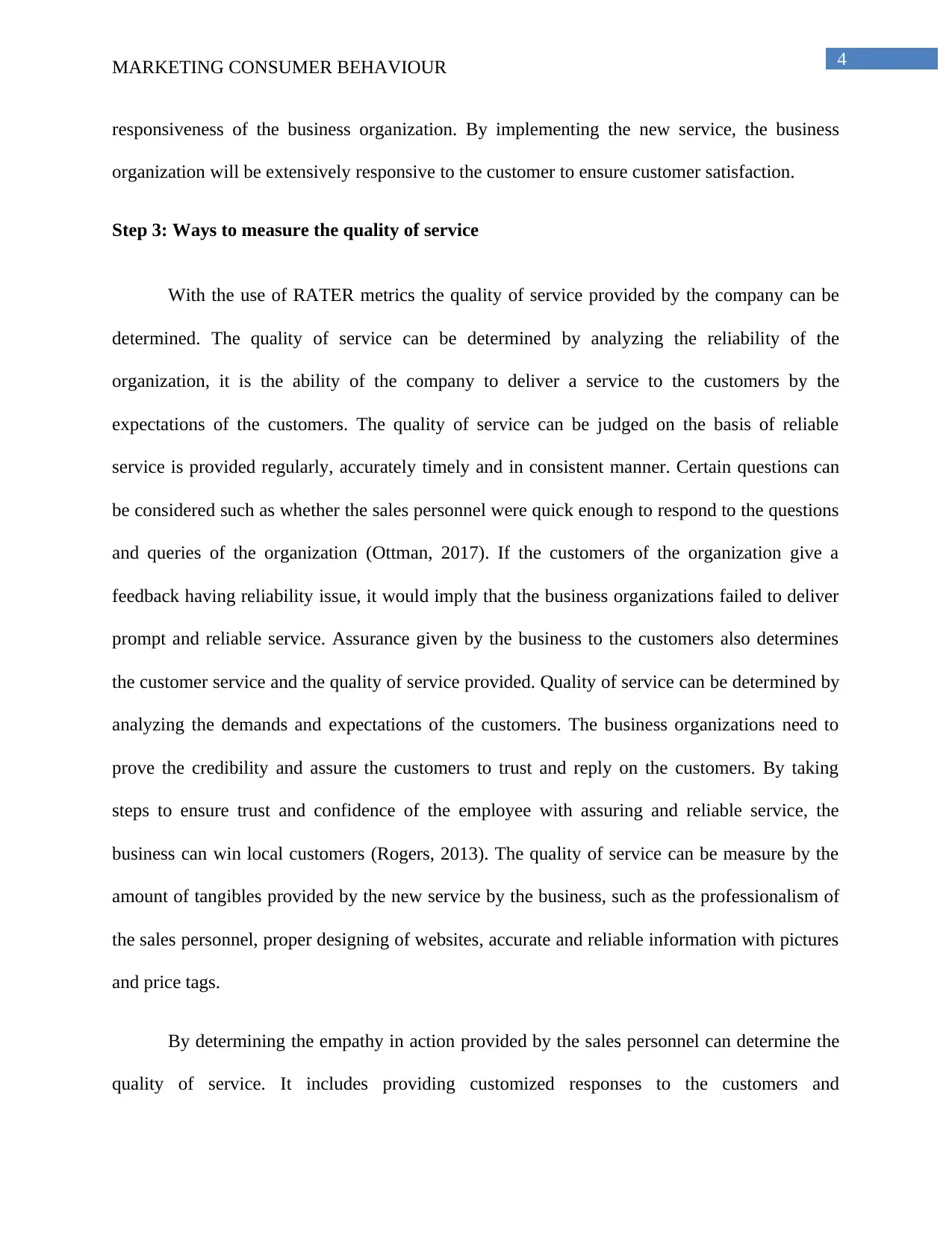
4MARKETING CONSUMER BEHAVIOUR
responsiveness of the business organization. By implementing the new service, the business
organization will be extensively responsive to the customer to ensure customer satisfaction.
Step 3: Ways to measure the quality of service
With the use of RATER metrics the quality of service provided by the company can be
determined. The quality of service can be determined by analyzing the reliability of the
organization, it is the ability of the company to deliver a service to the customers by the
expectations of the customers. The quality of service can be judged on the basis of reliable
service is provided regularly, accurately timely and in consistent manner. Certain questions can
be considered such as whether the sales personnel were quick enough to respond to the questions
and queries of the organization (Ottman, 2017). If the customers of the organization give a
feedback having reliability issue, it would imply that the business organizations failed to deliver
prompt and reliable service. Assurance given by the business to the customers also determines
the customer service and the quality of service provided. Quality of service can be determined by
analyzing the demands and expectations of the customers. The business organizations need to
prove the credibility and assure the customers to trust and reply on the customers. By taking
steps to ensure trust and confidence of the employee with assuring and reliable service, the
business can win local customers (Rogers, 2013). The quality of service can be measure by the
amount of tangibles provided by the new service by the business, such as the professionalism of
the sales personnel, proper designing of websites, accurate and reliable information with pictures
and price tags.
By determining the empathy in action provided by the sales personnel can determine the
quality of service. It includes providing customized responses to the customers and
responsiveness of the business organization. By implementing the new service, the business
organization will be extensively responsive to the customer to ensure customer satisfaction.
Step 3: Ways to measure the quality of service
With the use of RATER metrics the quality of service provided by the company can be
determined. The quality of service can be determined by analyzing the reliability of the
organization, it is the ability of the company to deliver a service to the customers by the
expectations of the customers. The quality of service can be judged on the basis of reliable
service is provided regularly, accurately timely and in consistent manner. Certain questions can
be considered such as whether the sales personnel were quick enough to respond to the questions
and queries of the organization (Ottman, 2017). If the customers of the organization give a
feedback having reliability issue, it would imply that the business organizations failed to deliver
prompt and reliable service. Assurance given by the business to the customers also determines
the customer service and the quality of service provided. Quality of service can be determined by
analyzing the demands and expectations of the customers. The business organizations need to
prove the credibility and assure the customers to trust and reply on the customers. By taking
steps to ensure trust and confidence of the employee with assuring and reliable service, the
business can win local customers (Rogers, 2013). The quality of service can be measure by the
amount of tangibles provided by the new service by the business, such as the professionalism of
the sales personnel, proper designing of websites, accurate and reliable information with pictures
and price tags.
By determining the empathy in action provided by the sales personnel can determine the
quality of service. It includes providing customized responses to the customers and
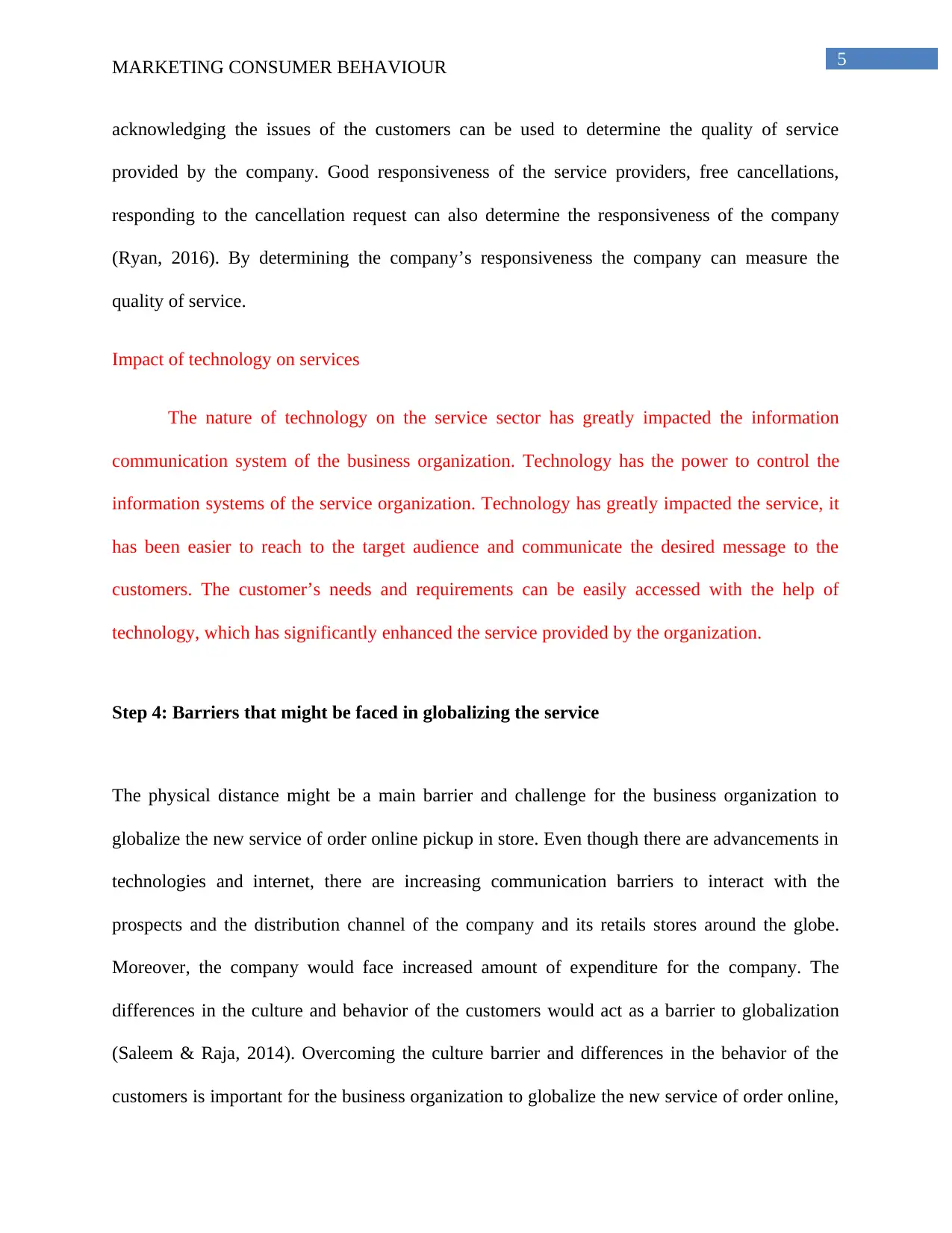
5MARKETING CONSUMER BEHAVIOUR
acknowledging the issues of the customers can be used to determine the quality of service
provided by the company. Good responsiveness of the service providers, free cancellations,
responding to the cancellation request can also determine the responsiveness of the company
(Ryan, 2016). By determining the company’s responsiveness the company can measure the
quality of service.
Impact of technology on services
The nature of technology on the service sector has greatly impacted the information
communication system of the business organization. Technology has the power to control the
information systems of the service organization. Technology has greatly impacted the service, it
has been easier to reach to the target audience and communicate the desired message to the
customers. The customer’s needs and requirements can be easily accessed with the help of
technology, which has significantly enhanced the service provided by the organization.
Step 4: Barriers that might be faced in globalizing the service
The physical distance might be a main barrier and challenge for the business organization to
globalize the new service of order online pickup in store. Even though there are advancements in
technologies and internet, there are increasing communication barriers to interact with the
prospects and the distribution channel of the company and its retails stores around the globe.
Moreover, the company would face increased amount of expenditure for the company. The
differences in the culture and behavior of the customers would act as a barrier to globalization
(Saleem & Raja, 2014). Overcoming the culture barrier and differences in the behavior of the
customers is important for the business organization to globalize the new service of order online,
acknowledging the issues of the customers can be used to determine the quality of service
provided by the company. Good responsiveness of the service providers, free cancellations,
responding to the cancellation request can also determine the responsiveness of the company
(Ryan, 2016). By determining the company’s responsiveness the company can measure the
quality of service.
Impact of technology on services
The nature of technology on the service sector has greatly impacted the information
communication system of the business organization. Technology has the power to control the
information systems of the service organization. Technology has greatly impacted the service, it
has been easier to reach to the target audience and communicate the desired message to the
customers. The customer’s needs and requirements can be easily accessed with the help of
technology, which has significantly enhanced the service provided by the organization.
Step 4: Barriers that might be faced in globalizing the service
The physical distance might be a main barrier and challenge for the business organization to
globalize the new service of order online pickup in store. Even though there are advancements in
technologies and internet, there are increasing communication barriers to interact with the
prospects and the distribution channel of the company and its retails stores around the globe.
Moreover, the company would face increased amount of expenditure for the company. The
differences in the culture and behavior of the customers would act as a barrier to globalization
(Saleem & Raja, 2014). Overcoming the culture barrier and differences in the behavior of the
customers is important for the business organization to globalize the new service of order online,
⊘ This is a preview!⊘
Do you want full access?
Subscribe today to unlock all pages.

Trusted by 1+ million students worldwide
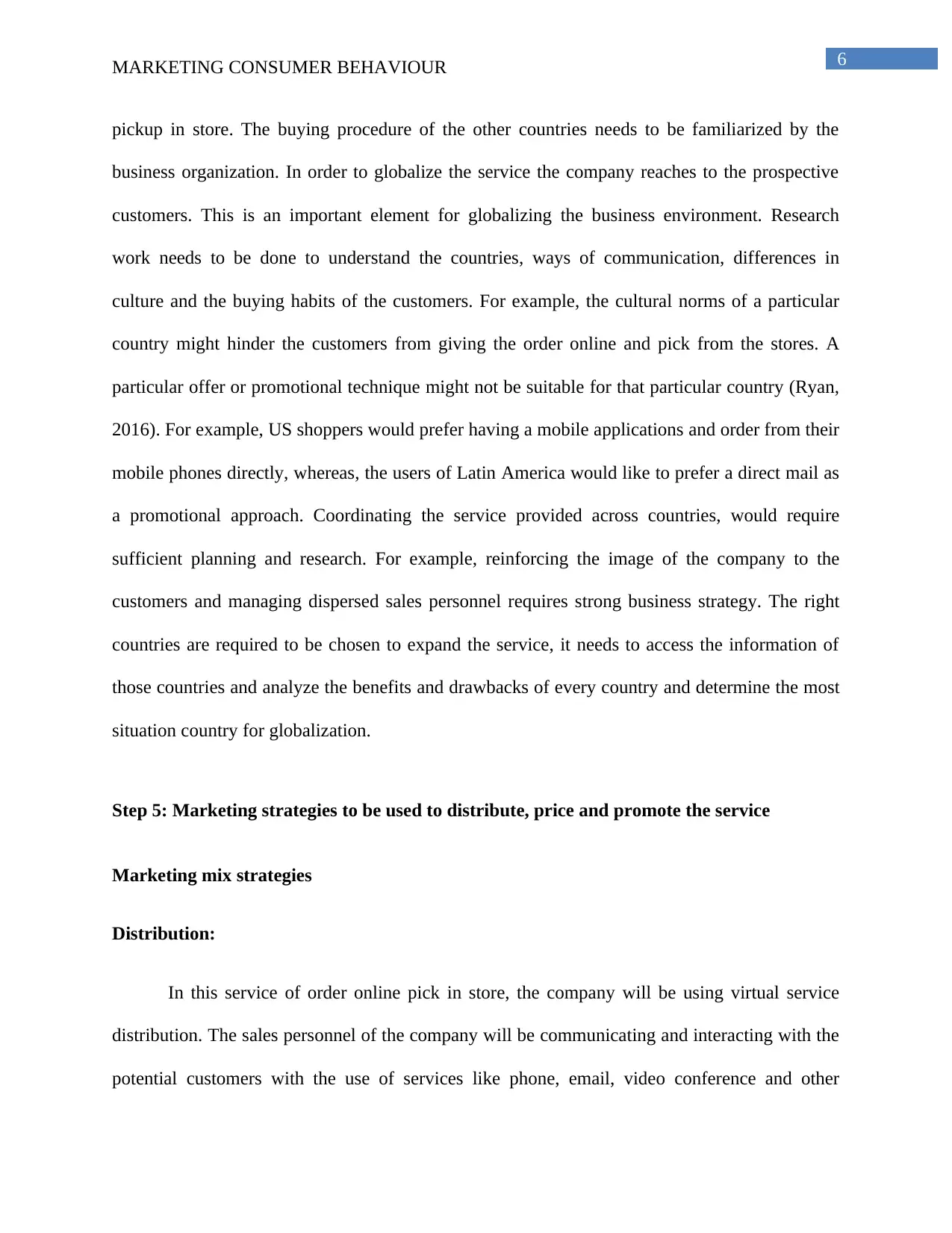
6MARKETING CONSUMER BEHAVIOUR
pickup in store. The buying procedure of the other countries needs to be familiarized by the
business organization. In order to globalize the service the company reaches to the prospective
customers. This is an important element for globalizing the business environment. Research
work needs to be done to understand the countries, ways of communication, differences in
culture and the buying habits of the customers. For example, the cultural norms of a particular
country might hinder the customers from giving the order online and pick from the stores. A
particular offer or promotional technique might not be suitable for that particular country (Ryan,
2016). For example, US shoppers would prefer having a mobile applications and order from their
mobile phones directly, whereas, the users of Latin America would like to prefer a direct mail as
a promotional approach. Coordinating the service provided across countries, would require
sufficient planning and research. For example, reinforcing the image of the company to the
customers and managing dispersed sales personnel requires strong business strategy. The right
countries are required to be chosen to expand the service, it needs to access the information of
those countries and analyze the benefits and drawbacks of every country and determine the most
situation country for globalization.
Step 5: Marketing strategies to be used to distribute, price and promote the service
Marketing mix strategies
Distribution:
In this service of order online pick in store, the company will be using virtual service
distribution. The sales personnel of the company will be communicating and interacting with the
potential customers with the use of services like phone, email, video conference and other
pickup in store. The buying procedure of the other countries needs to be familiarized by the
business organization. In order to globalize the service the company reaches to the prospective
customers. This is an important element for globalizing the business environment. Research
work needs to be done to understand the countries, ways of communication, differences in
culture and the buying habits of the customers. For example, the cultural norms of a particular
country might hinder the customers from giving the order online and pick from the stores. A
particular offer or promotional technique might not be suitable for that particular country (Ryan,
2016). For example, US shoppers would prefer having a mobile applications and order from their
mobile phones directly, whereas, the users of Latin America would like to prefer a direct mail as
a promotional approach. Coordinating the service provided across countries, would require
sufficient planning and research. For example, reinforcing the image of the company to the
customers and managing dispersed sales personnel requires strong business strategy. The right
countries are required to be chosen to expand the service, it needs to access the information of
those countries and analyze the benefits and drawbacks of every country and determine the most
situation country for globalization.
Step 5: Marketing strategies to be used to distribute, price and promote the service
Marketing mix strategies
Distribution:
In this service of order online pick in store, the company will be using virtual service
distribution. The sales personnel of the company will be communicating and interacting with the
potential customers with the use of services like phone, email, video conference and other
Paraphrase This Document
Need a fresh take? Get an instant paraphrase of this document with our AI Paraphraser
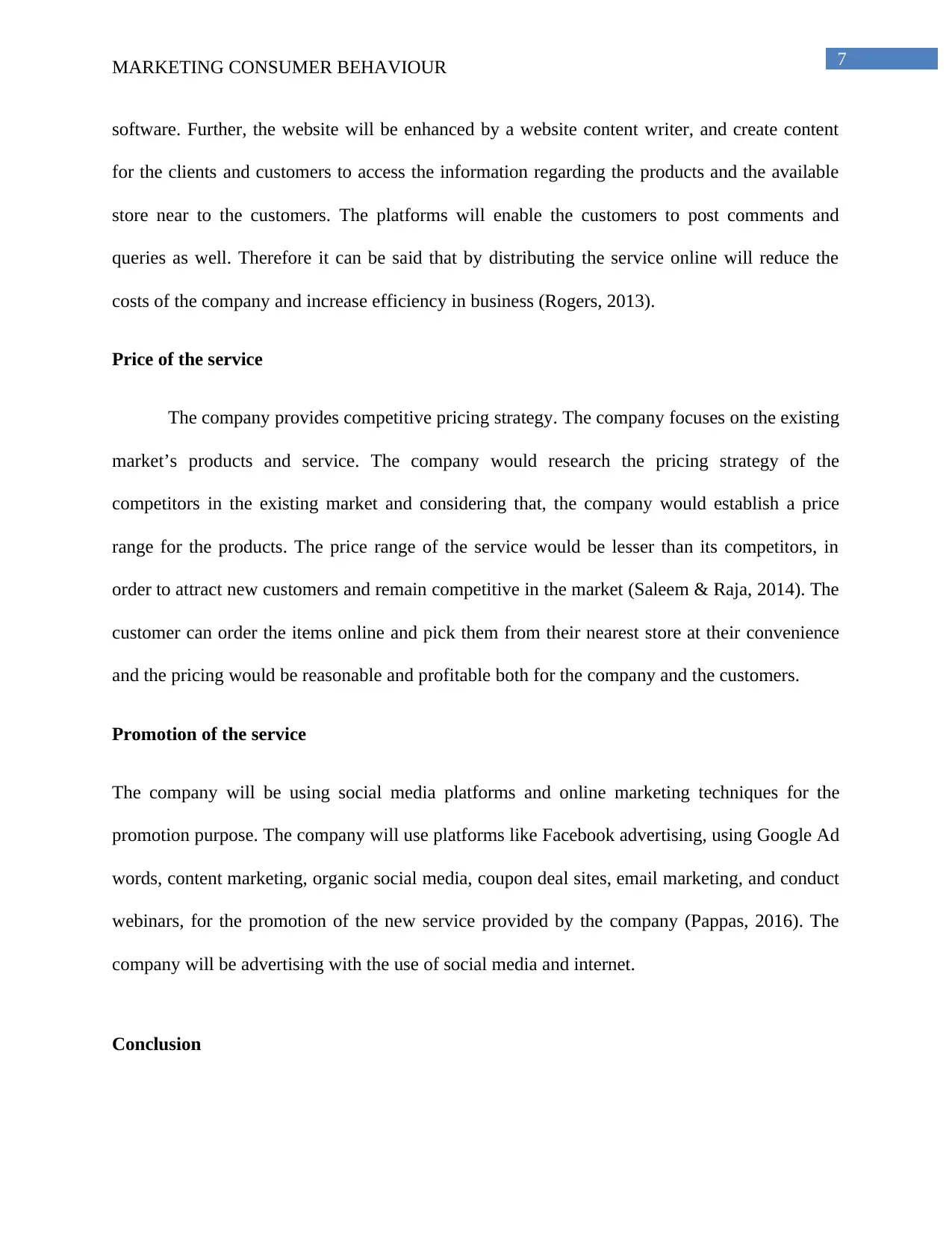
7MARKETING CONSUMER BEHAVIOUR
software. Further, the website will be enhanced by a website content writer, and create content
for the clients and customers to access the information regarding the products and the available
store near to the customers. The platforms will enable the customers to post comments and
queries as well. Therefore it can be said that by distributing the service online will reduce the
costs of the company and increase efficiency in business (Rogers, 2013).
Price of the service
The company provides competitive pricing strategy. The company focuses on the existing
market’s products and service. The company would research the pricing strategy of the
competitors in the existing market and considering that, the company would establish a price
range for the products. The price range of the service would be lesser than its competitors, in
order to attract new customers and remain competitive in the market (Saleem & Raja, 2014). The
customer can order the items online and pick them from their nearest store at their convenience
and the pricing would be reasonable and profitable both for the company and the customers.
Promotion of the service
The company will be using social media platforms and online marketing techniques for the
promotion purpose. The company will use platforms like Facebook advertising, using Google Ad
words, content marketing, organic social media, coupon deal sites, email marketing, and conduct
webinars, for the promotion of the new service provided by the company (Pappas, 2016). The
company will be advertising with the use of social media and internet.
Conclusion
software. Further, the website will be enhanced by a website content writer, and create content
for the clients and customers to access the information regarding the products and the available
store near to the customers. The platforms will enable the customers to post comments and
queries as well. Therefore it can be said that by distributing the service online will reduce the
costs of the company and increase efficiency in business (Rogers, 2013).
Price of the service
The company provides competitive pricing strategy. The company focuses on the existing
market’s products and service. The company would research the pricing strategy of the
competitors in the existing market and considering that, the company would establish a price
range for the products. The price range of the service would be lesser than its competitors, in
order to attract new customers and remain competitive in the market (Saleem & Raja, 2014). The
customer can order the items online and pick them from their nearest store at their convenience
and the pricing would be reasonable and profitable both for the company and the customers.
Promotion of the service
The company will be using social media platforms and online marketing techniques for the
promotion purpose. The company will use platforms like Facebook advertising, using Google Ad
words, content marketing, organic social media, coupon deal sites, email marketing, and conduct
webinars, for the promotion of the new service provided by the company (Pappas, 2016). The
company will be advertising with the use of social media and internet.
Conclusion
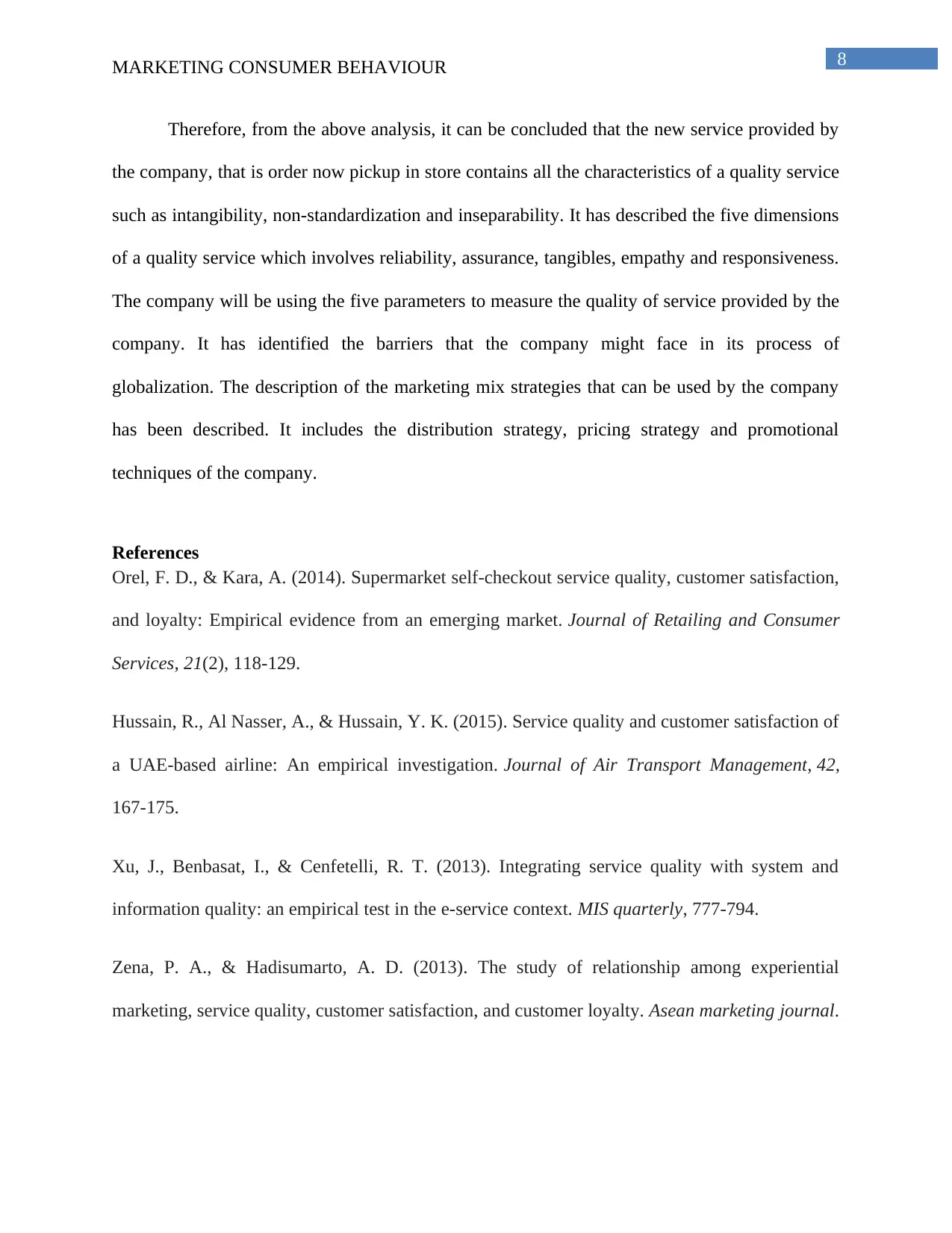
8MARKETING CONSUMER BEHAVIOUR
Therefore, from the above analysis, it can be concluded that the new service provided by
the company, that is order now pickup in store contains all the characteristics of a quality service
such as intangibility, non-standardization and inseparability. It has described the five dimensions
of a quality service which involves reliability, assurance, tangibles, empathy and responsiveness.
The company will be using the five parameters to measure the quality of service provided by the
company. It has identified the barriers that the company might face in its process of
globalization. The description of the marketing mix strategies that can be used by the company
has been described. It includes the distribution strategy, pricing strategy and promotional
techniques of the company.
References
Orel, F. D., & Kara, A. (2014). Supermarket self-checkout service quality, customer satisfaction,
and loyalty: Empirical evidence from an emerging market. Journal of Retailing and Consumer
Services, 21(2), 118-129.
Hussain, R., Al Nasser, A., & Hussain, Y. K. (2015). Service quality and customer satisfaction of
a UAE-based airline: An empirical investigation. Journal of Air Transport Management, 42,
167-175.
Xu, J., Benbasat, I., & Cenfetelli, R. T. (2013). Integrating service quality with system and
information quality: an empirical test in the e-service context. MIS quarterly, 777-794.
Zena, P. A., & Hadisumarto, A. D. (2013). The study of relationship among experiential
marketing, service quality, customer satisfaction, and customer loyalty. Asean marketing journal.
Therefore, from the above analysis, it can be concluded that the new service provided by
the company, that is order now pickup in store contains all the characteristics of a quality service
such as intangibility, non-standardization and inseparability. It has described the five dimensions
of a quality service which involves reliability, assurance, tangibles, empathy and responsiveness.
The company will be using the five parameters to measure the quality of service provided by the
company. It has identified the barriers that the company might face in its process of
globalization. The description of the marketing mix strategies that can be used by the company
has been described. It includes the distribution strategy, pricing strategy and promotional
techniques of the company.
References
Orel, F. D., & Kara, A. (2014). Supermarket self-checkout service quality, customer satisfaction,
and loyalty: Empirical evidence from an emerging market. Journal of Retailing and Consumer
Services, 21(2), 118-129.
Hussain, R., Al Nasser, A., & Hussain, Y. K. (2015). Service quality and customer satisfaction of
a UAE-based airline: An empirical investigation. Journal of Air Transport Management, 42,
167-175.
Xu, J., Benbasat, I., & Cenfetelli, R. T. (2013). Integrating service quality with system and
information quality: an empirical test in the e-service context. MIS quarterly, 777-794.
Zena, P. A., & Hadisumarto, A. D. (2013). The study of relationship among experiential
marketing, service quality, customer satisfaction, and customer loyalty. Asean marketing journal.
⊘ This is a preview!⊘
Do you want full access?
Subscribe today to unlock all pages.

Trusted by 1+ million students worldwide
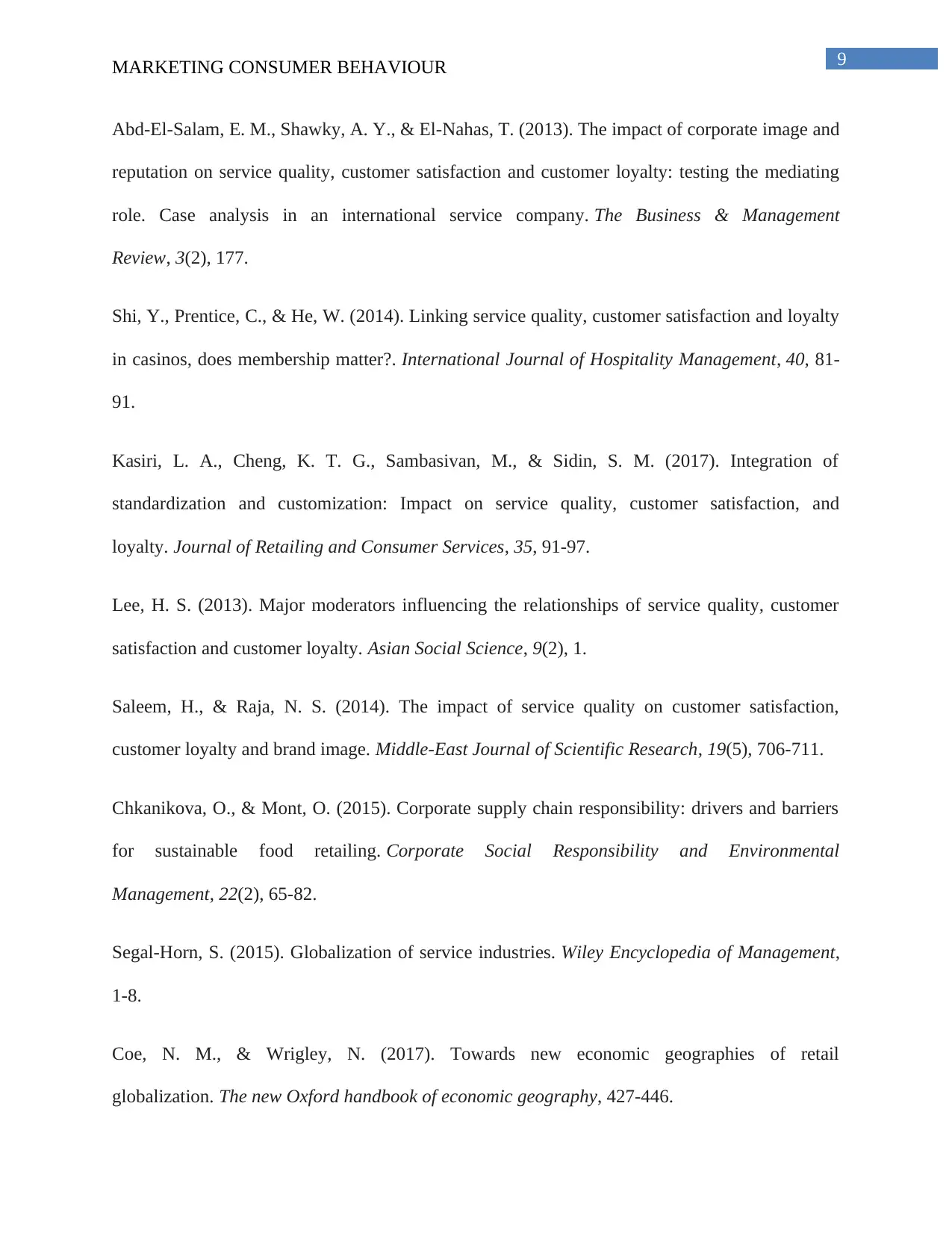
9MARKETING CONSUMER BEHAVIOUR
Abd-El-Salam, E. M., Shawky, A. Y., & El-Nahas, T. (2013). The impact of corporate image and
reputation on service quality, customer satisfaction and customer loyalty: testing the mediating
role. Case analysis in an international service company. The Business & Management
Review, 3(2), 177.
Shi, Y., Prentice, C., & He, W. (2014). Linking service quality, customer satisfaction and loyalty
in casinos, does membership matter?. International Journal of Hospitality Management, 40, 81-
91.
Kasiri, L. A., Cheng, K. T. G., Sambasivan, M., & Sidin, S. M. (2017). Integration of
standardization and customization: Impact on service quality, customer satisfaction, and
loyalty. Journal of Retailing and Consumer Services, 35, 91-97.
Lee, H. S. (2013). Major moderators influencing the relationships of service quality, customer
satisfaction and customer loyalty. Asian Social Science, 9(2), 1.
Saleem, H., & Raja, N. S. (2014). The impact of service quality on customer satisfaction,
customer loyalty and brand image. Middle-East Journal of Scientific Research, 19(5), 706-711.
Chkanikova, O., & Mont, O. (2015). Corporate supply chain responsibility: drivers and barriers
for sustainable food retailing. Corporate Social Responsibility and Environmental
Management, 22(2), 65-82.
Segal‐Horn, S. (2015). Globalization of service industries. Wiley Encyclopedia of Management,
1-8.
Coe, N. M., & Wrigley, N. (2017). Towards new economic geographies of retail
globalization. The new Oxford handbook of economic geography, 427-446.
Abd-El-Salam, E. M., Shawky, A. Y., & El-Nahas, T. (2013). The impact of corporate image and
reputation on service quality, customer satisfaction and customer loyalty: testing the mediating
role. Case analysis in an international service company. The Business & Management
Review, 3(2), 177.
Shi, Y., Prentice, C., & He, W. (2014). Linking service quality, customer satisfaction and loyalty
in casinos, does membership matter?. International Journal of Hospitality Management, 40, 81-
91.
Kasiri, L. A., Cheng, K. T. G., Sambasivan, M., & Sidin, S. M. (2017). Integration of
standardization and customization: Impact on service quality, customer satisfaction, and
loyalty. Journal of Retailing and Consumer Services, 35, 91-97.
Lee, H. S. (2013). Major moderators influencing the relationships of service quality, customer
satisfaction and customer loyalty. Asian Social Science, 9(2), 1.
Saleem, H., & Raja, N. S. (2014). The impact of service quality on customer satisfaction,
customer loyalty and brand image. Middle-East Journal of Scientific Research, 19(5), 706-711.
Chkanikova, O., & Mont, O. (2015). Corporate supply chain responsibility: drivers and barriers
for sustainable food retailing. Corporate Social Responsibility and Environmental
Management, 22(2), 65-82.
Segal‐Horn, S. (2015). Globalization of service industries. Wiley Encyclopedia of Management,
1-8.
Coe, N. M., & Wrigley, N. (2017). Towards new economic geographies of retail
globalization. The new Oxford handbook of economic geography, 427-446.
Paraphrase This Document
Need a fresh take? Get an instant paraphrase of this document with our AI Paraphraser
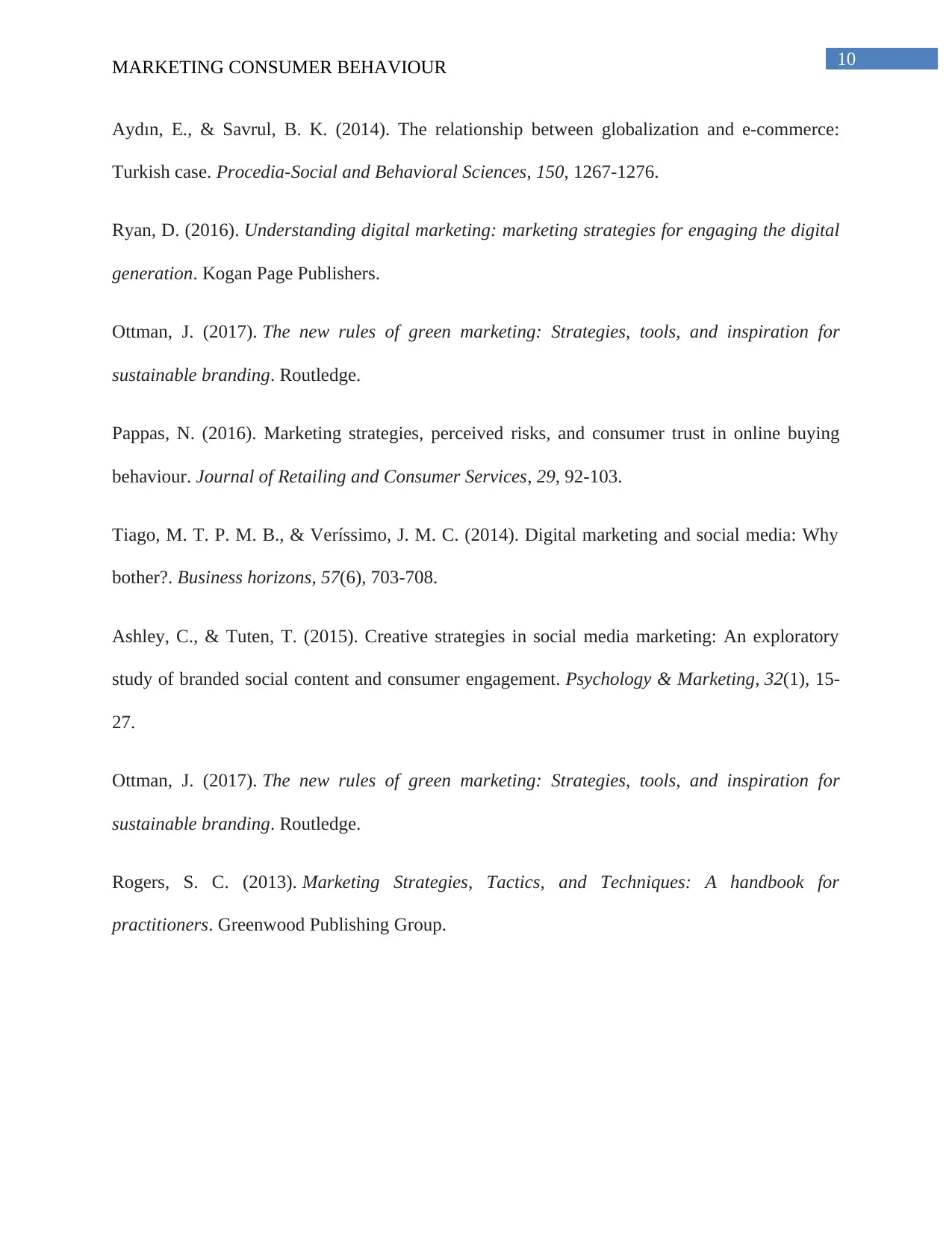
10MARKETING CONSUMER BEHAVIOUR
Aydın, E., & Savrul, B. K. (2014). The relationship between globalization and e-commerce:
Turkish case. Procedia-Social and Behavioral Sciences, 150, 1267-1276.
Ryan, D. (2016). Understanding digital marketing: marketing strategies for engaging the digital
generation. Kogan Page Publishers.
Ottman, J. (2017). The new rules of green marketing: Strategies, tools, and inspiration for
sustainable branding. Routledge.
Pappas, N. (2016). Marketing strategies, perceived risks, and consumer trust in online buying
behaviour. Journal of Retailing and Consumer Services, 29, 92-103.
Tiago, M. T. P. M. B., & Veríssimo, J. M. C. (2014). Digital marketing and social media: Why
bother?. Business horizons, 57(6), 703-708.
Ashley, C., & Tuten, T. (2015). Creative strategies in social media marketing: An exploratory
study of branded social content and consumer engagement. Psychology & Marketing, 32(1), 15-
27.
Ottman, J. (2017). The new rules of green marketing: Strategies, tools, and inspiration for
sustainable branding. Routledge.
Rogers, S. C. (2013). Marketing Strategies, Tactics, and Techniques: A handbook for
practitioners. Greenwood Publishing Group.
Aydın, E., & Savrul, B. K. (2014). The relationship between globalization and e-commerce:
Turkish case. Procedia-Social and Behavioral Sciences, 150, 1267-1276.
Ryan, D. (2016). Understanding digital marketing: marketing strategies for engaging the digital
generation. Kogan Page Publishers.
Ottman, J. (2017). The new rules of green marketing: Strategies, tools, and inspiration for
sustainable branding. Routledge.
Pappas, N. (2016). Marketing strategies, perceived risks, and consumer trust in online buying
behaviour. Journal of Retailing and Consumer Services, 29, 92-103.
Tiago, M. T. P. M. B., & Veríssimo, J. M. C. (2014). Digital marketing and social media: Why
bother?. Business horizons, 57(6), 703-708.
Ashley, C., & Tuten, T. (2015). Creative strategies in social media marketing: An exploratory
study of branded social content and consumer engagement. Psychology & Marketing, 32(1), 15-
27.
Ottman, J. (2017). The new rules of green marketing: Strategies, tools, and inspiration for
sustainable branding. Routledge.
Rogers, S. C. (2013). Marketing Strategies, Tactics, and Techniques: A handbook for
practitioners. Greenwood Publishing Group.
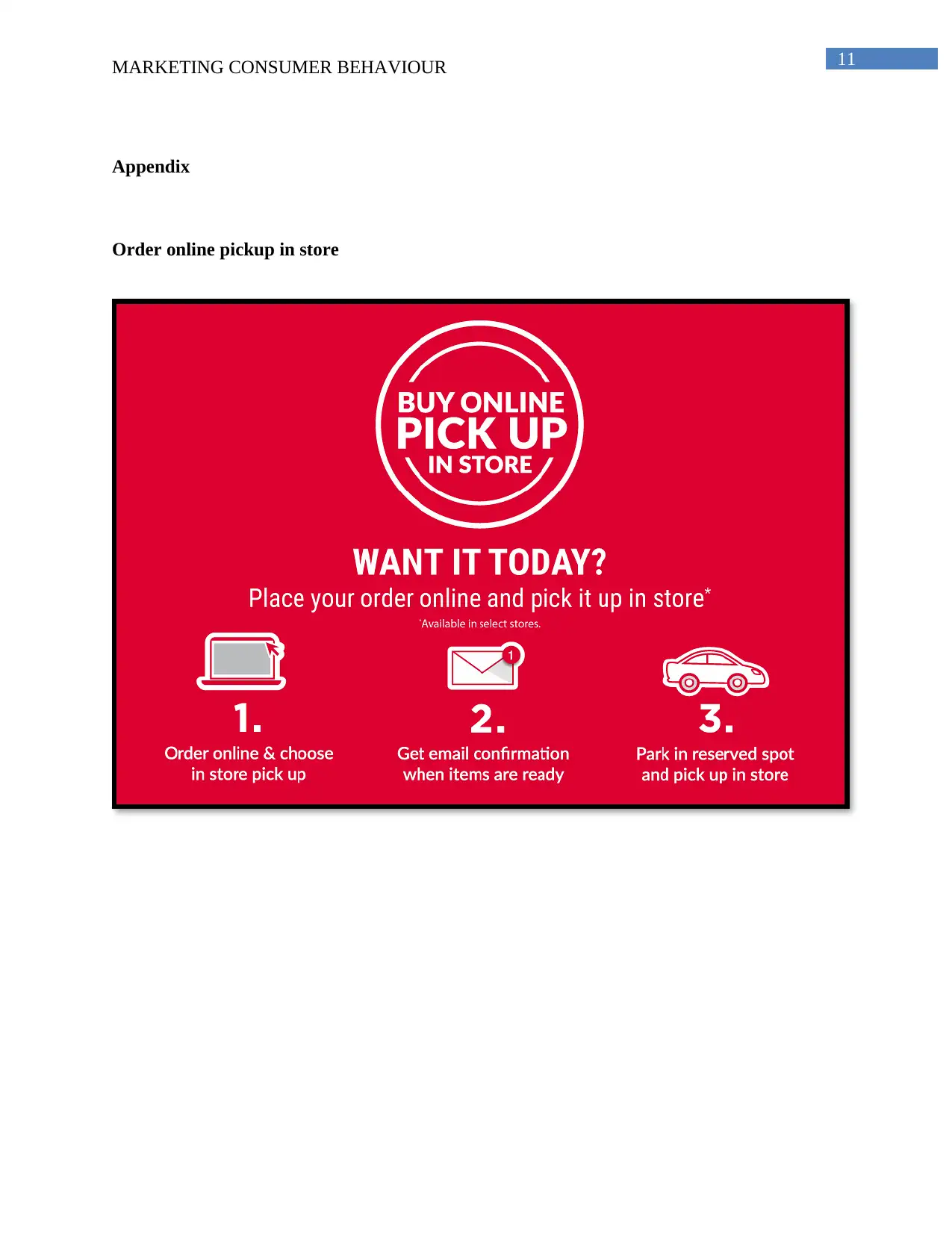
11MARKETING CONSUMER BEHAVIOUR
Appendix
Order online pickup in store
Appendix
Order online pickup in store
⊘ This is a preview!⊘
Do you want full access?
Subscribe today to unlock all pages.

Trusted by 1+ million students worldwide
1 out of 14
Related Documents
Your All-in-One AI-Powered Toolkit for Academic Success.
+13062052269
info@desklib.com
Available 24*7 on WhatsApp / Email
![[object Object]](/_next/static/media/star-bottom.7253800d.svg)
Unlock your academic potential
Copyright © 2020–2025 A2Z Services. All Rights Reserved. Developed and managed by ZUCOL.





